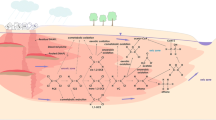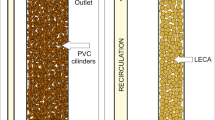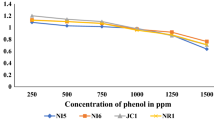Abstract
Bromate is a disinfection byproduct (DBP) that forms during the ozonation of bromide-containing natural water, which may cause health risks to humans. In this review, we provide an overview of the mechanism of bromate formation, microbial communities and bioreactors that are responsible for bromate reduction. Bromate can be formed through two pathways of bromide oxidation by ozone or by ·OH, and it can be removed by biological approaches. Members belonging to phyla of Spirochaetes, Proteobacteria, Firmicutes, Actinobacteria, Clostridium, Deinococcus-Thermus and Bacteroidetes have been identified as capable of reducing bromate to bromide. Multiple configurations of biofilm bioreactors have been employed to cultivate microbial communities to perform bromate removal. The rapid development of multiomics has and will continue to accelerate the elucidation of the mechanisms involved in bromate and other DBP conversions, as well as the interaction patterns among different bacterial subdivisions in the bioremoval of DBPs.


Similar content being viewed by others
References
Agus E, Voutchkov N, Sedlak DL (2009) Disinfection by-products and their potential impact on the quality of water produced by desalination systems: a literature review. Desalination 237(1–3):214–237
Assunção A, Martins M, Silva G, Lucas H, Coelho M, Costa M (2011) Bromate removal by anaerobic bacterial community: mechanism and phylogenetic characterization. J Hazard Mater 197:237–243
Butler R, Godley AR, Lake R, Lytton L, Cartmell E (2005) Reduction of bromate in groundwater with an ex situ suspended growth bioreactor. Water Sci Technol 52(9):265–273
Butler R, Ehrenberg S, Godley AR, Lake R, Lytton L, Cartmell E (2006) Remediation of bromate-contaminated groundwater in an ex situ fixed-film bioreactor. Sci Total Environ 366(1):12–20
Chairez M, Luna-Velasco A, Field JA, Ju X, Sierra-Alvarez R (2010) Reduction of bromate by biogenic sulfide produced during microbial sulfur disproportionation. Biodegradation 21:235–244
Chao Y, Mao Y, Wang Z, Zhang T (2015) Diversity and functions of bacterial community in drinking water biofilms revealed by high-throughput sequencing. Sci Rep 5:10044
Davidson AN, Chee-Sanford J, Lai HY, Ho CH, Klenzendorf JB, Kirisits MJ (2011) Characterization of bromate-reducing bacterial isolates and their potential for drinking water treatment. Water Res 45(18):6051–6062
Demirel S (2016) Denitrification performance and microbial community dynamics in a denitrification reactor by as revealed high-throughput sequencing. Water Sci Tech-W Sup 17(4):940–946
Demirel S, Uyanık İ, Yurtsever A, Çelikten H, Uçar D (2014) Simultaneous bromate and nitrate reduction in water using sulfur-utilizing autotrophic and mixotrophic denitrification processes in a fixed bed column reactor. Clean-Soil Air Water 42(9):1185–1189
Downing LS, Nerenberg R (2007) Kinetics of microbial bromate reduction in a hydrogen-oxidizing, denitrifying biofilm reactor. Biotechnol Bioeng 98(3):543–550
Fang JY, Shang C (2012) Bromate formation from bromide oxidation by the UV/persulfate process. Environ Sci Technol 46(16):8976–8983
Fischbacher A, Löppenberg K, von Sonntag C, Schmidt TC (2015) A new reaction pathway for bromite to bromate in the ozonation of bromide. Environ Sci Technol 49(19):11714–11720
Glaze WH, Weinberg HS, Cavanagh JE (1993) Evaluating the formation of brominated DBPs during ozonation. J Am Water Works Ass 85(1):96–103
Hijnen WAM, Voogt R, Veenendaal HR, van der Jagt H, van der Kooij D (1995) Bromate reduction by denitrifying bacteria. Appl Environ Microb 61:239–244
Hijnen W, Jong R, van der Kooij D (1999) Bromate removal in a denitrifying bioreactor used in water treatment. Water Res 33(4):1049–1053
Kirisits MJ, Snoeyink VL, Kruithof JP (2000) The reduction of bromate by granular activated carbon. Water Res 34(17):4250–4260
Kirisits MJ, Snoeyink VL, Inan H, Chee-Sanford JC, Raskin L, Brown JC (2001) Water quality factors affecting bromate reduction in biologically active carbon filters. Water Res 35(4):891–900
Kirisits MJ, Snoeyink VL, Chee-Sanford JC, Daugherty BJ, Brown JC, Raskin L (2002) Effect of operating conditions on bromate removal efficiency in BAC filters. J Am Water Works Ass 94(4):182–193
Krasner SW, Glaze WH, Weinberg HS, Daniel PA, Najm IN (1993) Formation and control of bromate during ozonation of waters containing bromide. J Am Water Works Ass 85(1):73–81
Kruithof J, Meijers R (1995) Bromate formation by ozonation and advanced oxidation and potential options in drinking water treatment. Water Supply 13:93
Lai CY, Lv PL, Dong QY, Yeo S, Rittmann BE, Zhao HP (2018) Bromate and nitrate bio-reduction coupled with poly-β-Hydroxybutyrate production in a methane-based membrane biofilm reactor. Environ Sci Technol 52(12):7024–7031
Li H, Zhang H, Jiang M, Han Y, Lin H, Xia S (2017) Feasibility of bioreductive degradation of bromate in water by autohydrogenotrophic microorganisms. Res Environ Sci 30(6):960–966. https://doi.org/10.13198/j.issn.1001-6929.2017.02.07
Liu J, Yu J, Li D, Zhang Y, Yang M (2012) Reduction of bromate in a biological activated carbon filter under high bulk dissolved oxygen conditions and characterization of bromate-reducing isolates. Biochem Eng J 65:44–50
Liu Y, Yang Y, Pang S, Zhang L, Ma J, Luo C, Guan C, Jiang J (2018) Mechanistic insight into suppression of bromate formation by dissolved organic matters in sulfate radical-based advanced oxidation processes. Biochem Eng J 333:200–205
Luo J, Wu M, Yuan Z, Guo J (2017) Biological bromate reduction driven by methane in a membrane biofilm reactor. Environ Sci Tech Lett 4(12):562–566
Lv P, Shi L, Wang Z, Rittmann B, Zhao H (2019) Methane oxidation coupled to perchlorate reduction in a membrane biofilm batch reactor. Sci Total Environ 667:9–15
Mao Y, Xia Y, Wang Z, Zhang T (2014a) Reconstructing a Thauera genome from a hydrogenotrophic-denitrifying consortium using metagenomic sequence data. Appl Microbiol Biotechnol 98(15):6885–6895
Mao Y, Yu K, Xia Y, Chao Y, Zhang T (2014b) Genome reconstruction and gene expression of “Candidatus Accumulibacter phosphatis” clade IB performing biological phosphorus removal. Environ Sci Technol 48(17):10363–10371
Matos C, Velizarov S, Crespo JG, Reis MA (2005) Removal of bromate, perchlorate and nitrate from drinking water in an ion exchange membrane bioreactor. Water Sci Tech-W Sup 5(5):9–14
Matos CT, Velizarov S, Crespo JG, Reis MA (2006) Simultaneous removal of perchlorate and nitrate from drinking water using the ion exchange membrane bioreactor concept. Water Res 40(2):231–240
Matos CT, Velizarov S, Reis MAM, Crespo JG (2008) Removal of bromate from drinking water using the ion exchange membrane bioreactor concept. Environ Sci Technol 42(20):7702–7708
Matos CT, Sequeira AM, Velizarov S, Crespo JG, Reis MAM (2009) Nitrate removal in a closed marine system through the ion exchange membrane bioreactor. J Hazard Mater 166(1):428–434
Nerenberg R, Rittmann B (2004) Hydrogen-based, hollow-fiber membrane biofilm reactor for reduction of perchlorate and other oxidized contaminants. Water Sci Technol 49(11–12):223–230
Nicoson JS, Wang L, Becker RH, Huff Hartz KE, Muller CE, Margerum DW (2002) Kinetics and mechanisms of the ozone/bromite and ozone/chlorite reactions. Inorg Chem 41(11):2975–2980
Oehmen A, Viegas R, Velizarov S, Reis MAM, Crespo JG (2006) Removal of heavy metals from drinking water supplies through the ion exchange membrane bioreactor. Desalination 199(1–3):405–407
Pinkernell U, von Gunten U (2001) Bromate minimization during ozonation: mechanistic considerations. Environ Sci Technol 35(12):2525–2531
Plewa MJ, Wagner ED, Richardson SD, Thruston AD, Woo YT, McKague AB (2004) Chemical and biological characterization of newly discovered iodoacid drinking water disinfection byproducts. Environ Sci Technol 38(18):4713–4722
Rittmann BE, Nerenberg R, Lee KC, Najm I, Gillogly TE, Lehman GE, Adham SS (2004) Hydrogen-based hollow-fiber membrane biofilm reactor (MBfR) for removing oxidized contaminants. Water Sci Tech-W Sup 4(1):127–133
Tamai N, Ishii T, Sato Y, Fujiya H, Muramatsu Y, Okabe N, Amachi S (2016) Bromate reduction by Rhodococcus sp. Br-6 in the presence of multiple redox mediators. Environ Sci Technol 50:10527–10534
Van Ginkel CG, Middelhuis BJ, Spijk F, Abma WR (2005) Cometabolic reduction of bromate by a mixed culture of microorganisms using hydrogen gas in a gas-lift reactor. J Ind Microbiol Biotechnol 32(1):1–6
Von Gunten U (2003) Ozonation of drinking water: Part II Disinfection and by-product formation in presence of bromide, iodide or chlorine. Water Res 37(7):1469–1487
Wolterink A, Schiltz E, Hagedoorn PL, Hagen WR, Kengen SWM, Stams AJM (2003) Characterization of the chlorate reductase from Pseudomonas chloritidismutans. J Bacteriol 185:3210–3213
Xu P, Janex ML, Savoye P, Cockx A, Lazarova V (2002) Wastewater disinfection by ozone: main parameters for process design. Water Res 36(4):1043–1055
Zhong Y, Li X, Yang Q, Wang D, Yao F, Li X, Zhao J, Xu Q, Zhang C, Zeng G (2016) Complete bromate and nitrate reduction using hydrogen as the sole electron donor in a rotating biofilm-electrode reactor. J Hazard Mater 307:82–90
Zhong Y, Yang Q, Fu G, Xu Y, Cheng Y, Chen C, Xiang R, Wen T, Li X, Zeng G (2018) Denitrifying microbial community with the ability to bromate reduction in a rotating biofilm-electrode reactor. J Hazard Mater 342:150–157
Ziv-El MC, Rittmann BE (2009) Systematic evaluation of nitrate and perchlorate bioreduction kinetics in groundwater using a hydrogen-based membrane biofilm reactor. Water Res 43(1):173–181
Acknowledgements
This study was funded by the National Natural Science Foundation of China (Grant No. 51608329), Natural Science Foundation of Guangdong (Grant No. 2017A030313315), Shenzhen Science and Technology Project (Grant Nos. JCYJ20160520165135743, JCYJ20170412171918012), National Major Science and Technology Program for Water Pollution Control and Treatment (Grant No. 2017ZX07202) and Natural Science Foundation of Shenzhen University (Grant Nos. 827-000223 and 2016008).
Author information
Authors and Affiliations
Corresponding author
Additional information
Publisher's Note
Springer Nature remains neutral with regard to jurisdictional claims in published maps and institutional affiliations.
Rights and permissions
About this article
Cite this article
Lv, X., Wang, D., Iqbal, W. et al. Microbial reduction of bromate: current status and prospects. Biodegradation 30, 365–374 (2019). https://doi.org/10.1007/s10532-019-09882-x
Received:
Accepted:
Published:
Issue Date:
DOI: https://doi.org/10.1007/s10532-019-09882-x




